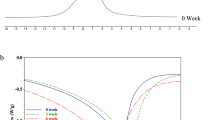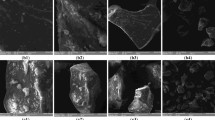Abstract
Algarroba flour is used to supplement lysine-limiting systems such as wheat flour due to its amino acidic composition. The effects of adding up to 30% of this flour to wheat flour (W-A30) on dough characteristics and breadmaking performance were studied. Dough rheology was tested by farinograph, oscillatory rheometry and texture profile analyses. Molecular mobility was evaluated by nuclear magnetic resonance, and thermal properties were analyzed by differential scanning calorimetry and viscoamylograph studies. Besides, different bread quality parameters were evaluated. Incorporation of algarroba flour resulted into increase in water absorption, development time and degree of softening, and decrease in stability of wheat flour, leading to softer, less adhesive and elastic dough, although at intermediate replacement levels cohesiveness improved. At the molecular level, a reduction of water activity and limited proton motion were observed in W-A30 samples, suggesting that protons were highly bound to the dough matrix. Dough samples with algarroba flour showed lower G′ and G″ values than the control, although with the formation of a more elastic structure for W-A30. In addition, algarroba flour produced a protective effect on starch granule disruption and interfered with amylose–amylose association during cooling. The specific volume of breads decreased with the increase in algarroba level, W-A30 reaching the highest decrease (15%). Bread crumbs with algarroba flour exhibited higher values of hardness and resilience. The use of algarroba flour resulted in lower quality when compared to the control. However, algarroba flour at 20% level can be added to wheat flour to obtain bakery products of similar technological quality and with improved nutritional components.




Similar content being viewed by others
References
AACC (2000) Approved methods of the American Association of Cereal Chemists. AACC, Washington
Argentinean Alimentarius Codex (2016) Chapter IX “Alimentos farináceos – Cereales, Harinas Y Derivados”
Balasubramanian S, Borah A, Singh K, Patil R (2012) Rheological and nutritional quality of selected dehulled legumes blended rice extrudates. J Food Sci Technol 49(5):632–637
Beresford-Jones D, Arce S, Whaley O, Chepstow-Lusty AJ (2009) The role of Prosopis in ecological and landscape change in the Samaca basin, lower Ica Valley, south coast Peru from the Earlier Horizon to the Late Intermediate period. Lat Am Antiq 20:303–332
Bigne F, Puppo MC, Ferrero C (2015) Rheological and microstructure characterization of composite dough with wheat and mesquite (Prosopis spp) flours. Int J Food Prop 19(2):242–256
Bigne F, Puppo MC, Ferrero C (2016) Fibre enrichment of wheat flour with mesquite (Prosopis spp.): effect on breadmaking performance and staling. LWT Food Sci Technol 65:1008–1016
Bourne MC (2002) Principles of objective texture measurement. In: Bourne MC (ed) Food texture and viscosity: concept and measurement. Academic Press, California
Buera MP, Retriella C, Lozano RD (1985) Definition of colour in the nonenzymatic browning. Farbe 33:316–326
Burkart A (1976) A monograph of the genus Prosopis (Leguminosae subfam. Mimosoideae). J Arnold Arbor 57(217–249):450–525
Cauvain SP (2004) Improving the texture of bread. In: Kilcast D (ed) Food texture vol 2: solid foods. Woodhead Publishing Limited, Cambridge
Cauvain SP (2012) Breadmaking: improving quality. Elsevier, Amsterdam
Correa MJ, Ferrer E, Añón MC, Ferrero C (2014) Interaction of modified celluloses and pectins with gluten proteins. Food Hydrocoll 35:91–99
Doxastakis G, Zafiriadis I, Irakli M et al (2002) Lupin, soya and triticale addition to wheat flour doughs and their effect on rheological properties. Food Chem 77:219–227
Duodu KG, Minnaar A (2011) Chapter 18—legume composite flours and baked goods: nutritional, functional, sensory, and phytochemical qualities. In: Patel VRPRWB (ed) Flour and breads and their fortification in health and disease prevention. Academic Press, San Diego, pp 193–203
Felker P, Takeoka G, Dao L (2013) Pod mesocarp flour of North and South American species of leguminous tree Prosopis (Mesquite): composition and food applications. Food Rev Int 29:49–66
Gallão MI, Vieira ÍG, Mendes FN et al (2007) Reserve mobilisation in mesquite (Prosopis juliflora) seed (Leguminosae). J Sci Food Agric 87:2012–2018
Ibañez MC, Ferrero C (2003) Extraction and characterization of the hydrocolloid from Prosopis flexuosa DC seeds. Food Res Int 36:455–460
Kaur A, Shevkani K, Katyal M et al (2016) Physicochemical and rheological properties of starch and flour from different durum wheat varieties and their relationships with noodle quality. J Food Sci Technol 53(4):2127–2138
Kerr WL, Wicker L (2000) NMR proton relaxation measurements of water associated with high methoxy and low methoxy pectins. Carbohydr Polym 42:133–141
Khatkar BS (2005) Effect of protein contents and water absorption values on dynamic rheological properties of wheat flour dough. J Food Sci Technol 42(4):358–366
Komlenić DK, Ugarčić-Hardi Ž, Jukić M et al (2010) Wheat dough rheology and bread quality effected by Lactobacillus brevis preferment, dry sourdough and lactic acid addition. Int J Food Sci Technol 45:1417–1425
Leung HK, Magnuson JA, Bruinsma BL (1979) Pulsed nuclear magnetic resonance study of water mobility in flour doughs. J Food Sci 44:1408–1411
Marangoni A, Alli I (1988) Composition and properties of seeds and pods of the tree legume Prosopis juliflora (DC). J Sci Food Agric 44:99–110
Mohammed I, Ahmed AR, Senge B (2012) Dough rheology and bread quality of wheat–chickpea flour blends. Ind Crops Prod 36:196–202
Mohammed I, Ahmed AR, Senge B (2014) Effects of chickpea flour on wheat pasting properties and bread making quality. Ind Crops Prod 51(9):1902–1910
Palou E, López-Malo A, Barbosa-Cánovas GV et al (1999) Polyphenoloxidase activity and color of blanched and high hydrostatic pressure treated banana puree. J Food Sci 64:42–45
Paraskevopoulou A, Provatidou E, Tsotsiou D, Kiosseoglou V (2010) Dough rheology and baking performance of wheat flour–lupin protein isolate blends. Food Res Int 43:1009–1016
Pasiecznik NM, Felker P, Harris PJC et al (2001) The Prosopis juliflora–Prosopis pallida complex: a monograph. Henry Doubleday Res Assoc Coventry UK, London
Sadasivam S, Manickam A (1992) Biochemical methods for agricultural sciences. Wiley Eastern Limited, New Yok
Salinas MV, Zuleta A, Ronayne P, Puppo M (2012) Wheat flour enriched with calcium and inulin: a study of hydration and rheological properties of dough. Food Bioprocess Technol 5:3129–3141
Salinas M, Carbas B, Brites C, Puppo M (2015) Influence of different carob fruit flours (Ceratonia siliqua L.) on wheat dough performance and bread quality. Food Bioprocess Technol 8:1561–1570
Salinas MV, Zuleta A, Ronayne P, Puppo MC (2016) Wheat bread enriched with organic calcium salts and inulin. A bread quality study. J Food Sci Technol 53:491–500
Sciammaro L, Ferrero C, Puppo M (2016) Chemical and nutritional properties of different fractions of Prosopis alba pods and seeds. J Food Meas Charact 10:103–112
Shewry PR (2004) Improving the protein content and quality of temperate cereals: wheat, barley and rye. In: Welch RM, Çakmak I (eds) Impacts of agriculture on human health and nutrition, Ross M. Welch, and Ismail Çakmak. UNESCO, Eolss Publishers, Oxford, pp 118–137
Shittu TA, Raji AO, Sanni LO (2007) Bread from composite cassava–wheat flour: I. Effect of baking time and temperature on some physical properties of bread loaf. Starch Funct III 40:280–290
Shittu TA, Dixon A, Awonorin SO et al (2008) Bread from composite cassava–wheat flour. II: effect of cassava genotype and nitrogen fertilizer on bread quality. Food Res Int 41:569–578
Singh N, Shevkani K, Kaur A, Thakur S, Parmar N, Virdi AS (2014) Characteristics of starch obtained at different stages of purification during commercial wet milling of maize. Starch 66:668–677
Yadav DN, Rajan A, Sharma GK, Bawa AS (2010) Effect of fiber incorporation on rheological and chapati making quality of wheat flour. J Food Sci Technol 47:166–173
Zhu H, Wang F, Huang W et al (2010) Rheofermentometer fermentation and breadmaking characteristics of dough containing xylo-oligosaccharide hydrolyzate from wheat bran. J Agric Food Chem 58:1878–1883
Acknowledgements
Authors would like to acknowledge the UNLP, CONICET and MINCYT (Argentina) and FCT (Portugal) for the financial support (MINCYT-FCT PO-0928-2009). Authors also want to thank the kind cooperation of Elena Golovushkina and Christopher Young for the English revision of the manuscript.
Author information
Authors and Affiliations
Corresponding author
Ethics declarations
Conflict of interest
The authors declare that they have no conflict of interest
Rights and permissions
About this article
Cite this article
Correa, M.J., Salinas, M.V., Carbas, B. et al. Technological quality of dough and breads from commercial algarroba–wheat flour blends. J Food Sci Technol 54, 2104–2114 (2017). https://doi.org/10.1007/s13197-017-2650-4
Revised:
Accepted:
Published:
Issue Date:
DOI: https://doi.org/10.1007/s13197-017-2650-4




